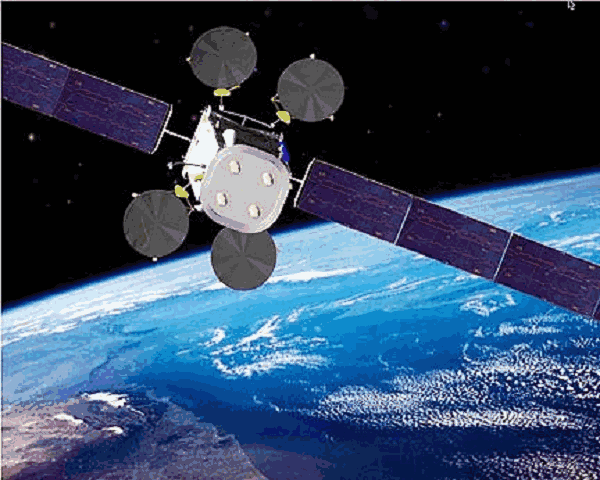
A twice-used Falcon 9 core stage stands ready on Space Launch Complex (SLC)-40 at Cape Canaveral Air Force Station, Fla., primed for a Monday evening mission to deliver the heavyweight JCSAT-18/Kacific-1 communications satellite to geostationary transfer orbit. The frequently-flown core—tailnumbered “B1056”—had previously seen service to deliver the CRS-17 and CRS-18 Dragon cargo ships to the International Space Station (ISS) in May and July 2019, respectively.
Monday’s launch will occur during an 88-minute “window” which extends from 7:10 p.m. through 8:38 p.m. EST and B1056 will be the fifth Falcon 9 to record three launches to its name.

Principal payload is JCSAT-18/Kacific-1, a high-throughput communications satellite jointly belonging to Kacific Broadband Satellites of Singapore and Japan’s SKY Perfect JSAT Corp. When operational, the satellite will spend a minimum of 15 years providing mobile telephone, data and internet services to users in the Asia-Pacific region. Its 56 Ka-band narrow beams each carry a capacity of up to 1.25 Gbps, which will afford the highest signal power ever achieved in the region. Specifically, JCSAT-18/Kacific-1 will target precise “pockets of demand” across a wide geographical area which encompasses 20 Pacific and Southeast Asian nations.
FOLLOW AmericaSpace’s Live Launch Tracker HERE.
Based upon Boeing’s tried-and-true 702MP “bus”, the 15,000-pound (6,800 kg) satellite was ordered in February 2017. “The scalable Boeing 702 satellite is a flight-proven design that we are evolving to meet the future needs of our customers,” said Mark Spiwak, president of Boeing Satellite Systems International, at the time of the contract award. “The combined JCSAT-18 and Kacific-1 satellite has the flexibility to accommodate various business requirements to meet the demands of both SKY Perfect JSAT and Kacific.”
The 702MP is a “medium-power” bus with a modularity that allows a reduced development time; less than three years will have elapsed since the contract award until JCSAT-18/Kacific-1 reaches orbit. Its tailored payload module interfaces with the bus at four key points and with just a handful of electrical connectors, affording it greater simplicity and cost efficiency. It also benefits from a Xenon-Ion Propulsion System (XIPS), reportedly ten times more efficient than regular liquid fuel, and this will be employed to achieve final orbital insertion. Historically, the 702MP has performed well, although several early missions—launched since 1999—sustained problems with outgassing-induced “fogging” of their solar array concentrators. This prompted the development and implementation of high-power, six-paneled triple-junction gallium arsenide cells.
Contracts to launch JCSAT-18/Kacific-1 aboard a SpaceX Falcon 9 were signed back in September 2017. “SpaceX has a breadth of vision that appeals to us,” said Christian Patouraux, chief executive officer of Kacific. “The company is committed to changing the way people think about space and the possibilities it presents. Signing with SpaceX as our launch service provider is a major step towards delivering our own vision.”
As SpaceX’s 13th launch of 2019, it might have seemed that performing the customary Static Fire Test of the nine Merlin 1D+ engines on Friday, 13 December risked ill-fortune. But against gloomy Florida skies, the 230-foot-tall (70-meter) booster—its first stage distinctly blackened from two previous launches and high-speed re-entries—trundled out from the Horizontal Integration Facility (HIF) to the SLC-40 pad surface early that morning. The static fire test occurred without incident and the Falcon 9 was returned to the horizontal and taken back undercover for the installation of the bullet-like payload fairing and JCSAT-18/Kacific-1. The complete stack was then returned to the pad for final preparations.
Weather conditions for Monday’s opening launch attempt are predicted to be highly favorable, with a 90-percent probability that the gods will align during the 88-minute window. “High pressure will move across the region this weekend, bringing clearing skies and dry conditions behind a departing frontal boundary,” noted the 45th Space Wing at Patrick Air Force Base in its L-3 briefing, issued Friday. “The high center will move into the Atlantic on Monday, allowing increasing southeasterly flow which may bring a few showers moving onshore Monday afternoon and evening.”

Primary meteorological issues for Monday include a cumulus clouds, although a 24-hour scrub and turnaround to Tuesday offers a much more iffy outlook, with only a 60-percent chance of acceptable weather. “Another frontal boundary will move into the region on Tuesday, bringing additional showers and the potential for a few storms to the Space Coast,” it was added. “While the exact timing of the front remains uncertain, it looks likely that increasing cloudiness associated with the boundary will reach the area by the launch window. The main weather concerns will be cumulus clouds and disturbed weather.”
Following launch, SpaceX will attempt to land the rocket offshore on their drone ship “Of Course I Still Love You (OCISLY),” while both ships “GO Ms Tree” and “GO Ms Chief” will attempt to recover the payload fairings.
With an expectation that SpaceX will loft its third batch of Starlink internet communications satellites before the end of December, the closing weeks of the year raise the possibility of 14 overall launches in 2019. Achievements to date—notwithstanding an unusual three-month quiet spell at the Cape between August and November—have included three ISS-bound Dragon cargo ships, two missions by the mammoth Falcon Heavy and the long-awaited maiden voyage of the Crew Dragon capsule. Fourteen missions promises to put 2019 into third place behind the 21 launches achieved in 2018 and 18 flights in 2017.
.
.
FOLLOW AmericaSpace on Facebook and Twitter!
.
.






Go Space X Go Elon Lets get to our new planet Mars Soon